From Tents to Towers to Kitchen Tables: The Evolution of the Law Office in Idaho by David H. Leroy
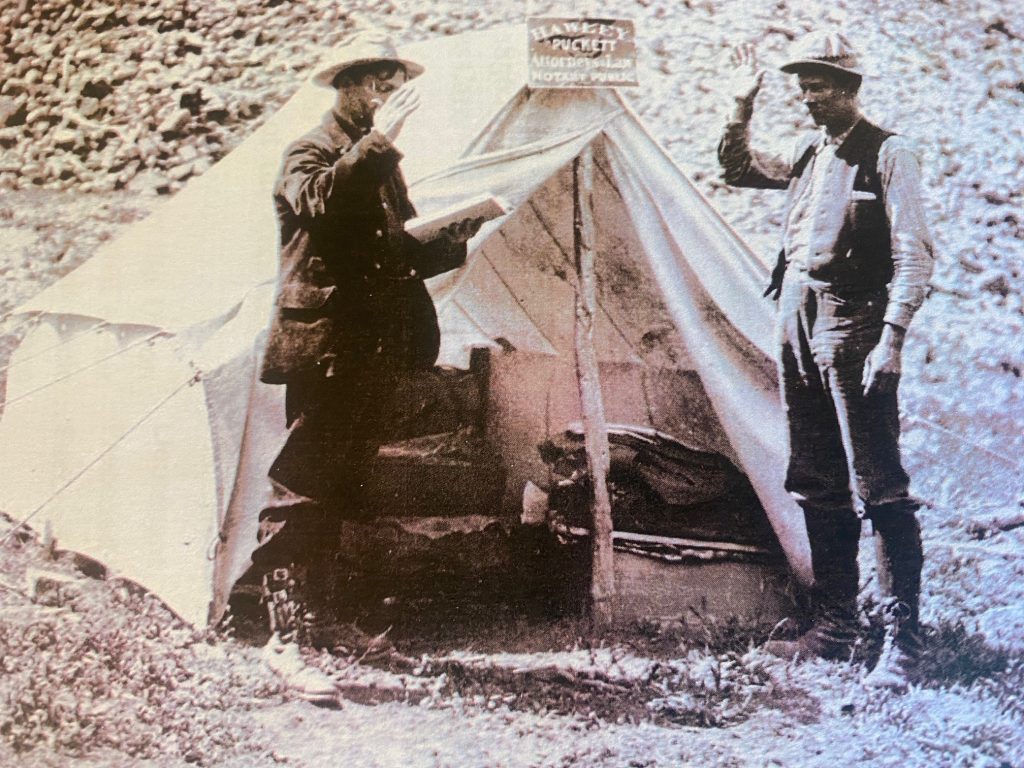
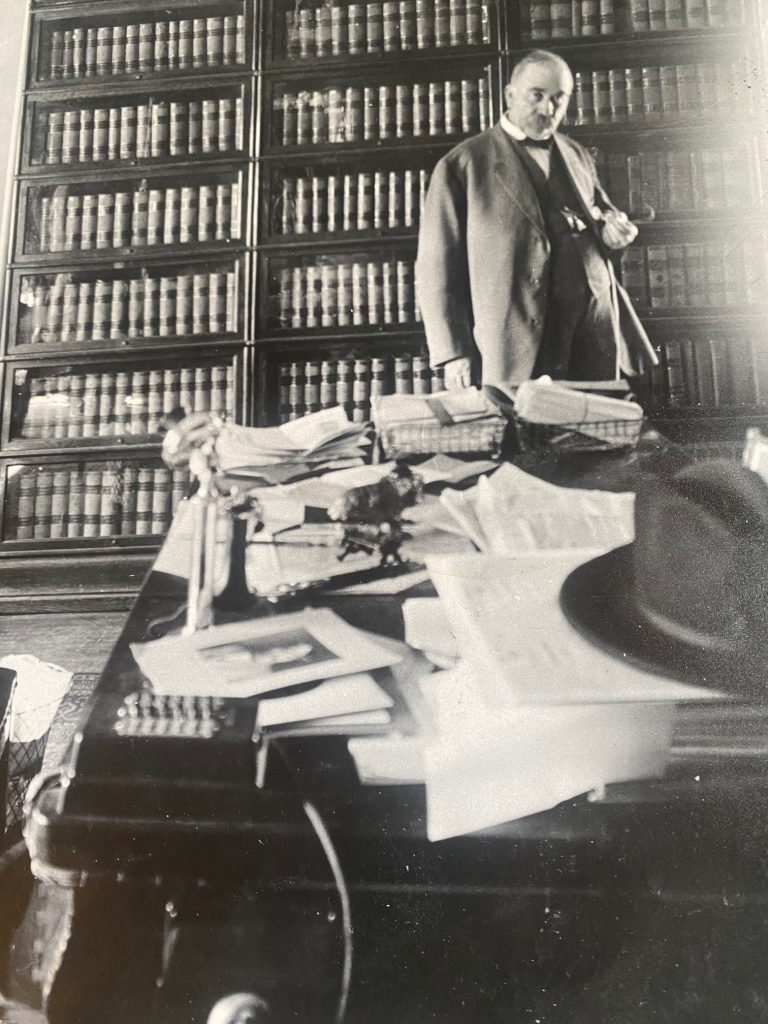
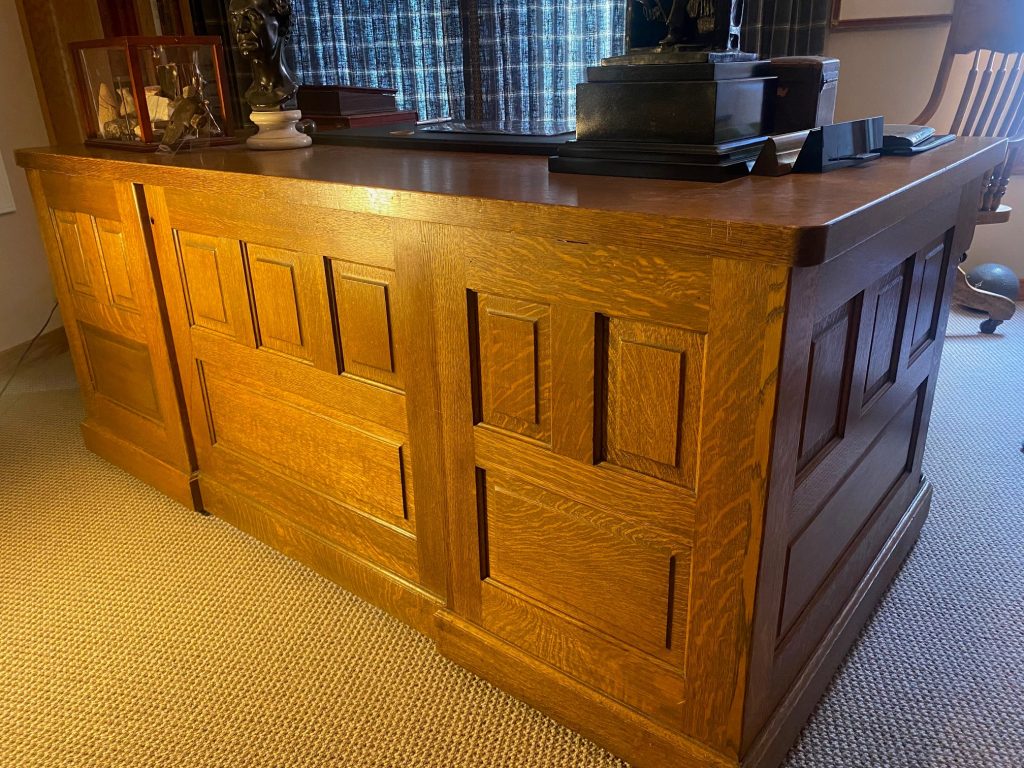
The Nineteenth Century
The iconic visual image of an early Idaho territorial-era law office has always been the photograph of the Hawley-Puckett canvas tent, hung with an “Attorneys at Law” sign, framed on either side by two pioneer-era men, one administering and one taking an oath against the backdrop of a rocky, timbered, steep mountain include.[i]
James H. Hawley was admitted to the Territorial Bar on February 14, 1871. However, William H. Puckett was not licensed here until February 28, 1893. This means that, rustic though the photo may be, this tented partnership law office dates to the early statehood days of the 1890s, not the territorial-era. Yet, no doubt many pioneer era-lawyers here did indeed practice from tents, saddlebags, and the backs of wagons.
However, evidence of wooden structured law offices also can be found three decades earlier in the columns of early Idaho newspapers. The Idaho City World of December 26, 1863, under the first page headline of “The Cabin in the Street,” ruminates against a citizen’s business building, erected in and blocking free passage along the town’s Main Street. It then refers to another structure, which is Idaho’s first known law office, using a very uncomplimentary architectural term:
“There is another shanty, partly in the lower end of the same street [which] we hope the Fire Company will not pull down, as we understand that it belongs to a lawyer and may be holding rights for him also. Elsewhere in this paper we publish statutes with regard to town plats which covers the whole case.”[ii]
By October 13, 1863, no fewer than four solo practitioners and at least three law partnerships were resident in West Bannock or Bannock City, as Idaho City was originally known. They were established at various locations, including on Main Street, below Wall Street and “in the building formerly occupied by Rockfellow’s Express.” Up the trail, Milton Kelly had co-located his practice inside the Wells Fargo Office in Placerville.[iii]
By the next year, Idaho’s first known second-floor law office location was attributed to Shafer and Nugent who could be found in Idaho City at “Wall & Montgomery, Upstairs” according to their front-page advertisement in the February 26, 1864 issue of the World. Three days earlier, Idaho Supreme Court Justice Sam Parks had convened in Idaho City the first District Court session ever held in the Territory, permitting to practice those locals who had “shown to the court that they had been admitted in other states and territories.”[iv]
In Boise City, the Idaho Statesman began carrying advertisements noting the existence of law offices almost as soon as it commenced publishing in the Summer of 1864. Issue Number Five on August Fourth, reported two local attorneys in residence and that D.S. Holton, Justice of the Peace, could be found at his “Office on Main Street.” Even though it was a two day stage coach ride between the towns, Idaho City lawyers also advertised their office locations and practices in Boise’s Statesman.[v] So did H.W.O. Margary, who had relocated from Idaho City after 1863 to the new mining “hot spot” of Rocky Bar, in now non-existent Alturas County, where he was soon joined by A.G. Cook.[vi]
Volume I of the Idaho Reports, as published in 1881, collects the decisions of record issued by our Territorial Supreme Court from the earliest years of the judicial system. It also contains a list of all the lawyers admitted to practice from 1866 to that date. Eighty two men were admitted in those fifteen years. Of that number, forty were reported to have left the Territory. Eight were deceased. Of the remaining practitioners, nearly all had their office locations concentrated in the three most populous and mineral-rich towns: Idaho City, Silver City, and Boise City.[vii]
By the 1880s a prosperous lawyer with long-term ambitions could move away from a frame structure and erect a purpose-build brick law office. One of the finest, still extant examples of that attainment can be found at 112 North Sixth Street in Boise. Richard Z. Johnson, a native of Ohio and 1859 Yale Law graduate, established a very successful practice in Silver City and became the presidentially-appointed territorial Attorney General for Idaho, serving from 1885 to 1890.[viii] Reportedly, Johnson was “probably the best educated and most learned lawyer in the country.” Johnson later became the first President of the Idaho State Bar.[ix] He appeared in nearly thirty percent of all reported cases before the Idaho Supreme Court between 1864 and 1881.[x]
Relocating to Boise, in 1885 he constructed a two-story, long and narrow edifice using local red brick, with a colonnaded step-up porch and arches above the windows and door. It projects solidarity and great dignity in the Greek Revival style. Inside, the walls support long, ceiling-high book shelves which held “the largest private law library in the State.” In the back office, precious papers and bullion could be secured behind a fortified bank-type door inside a large, thick floor safe. A rifle rack still hangs upon the wall. This pioneering law office, which its original legal volumes still in the shelves, remains unchanged nearly a century and a half later in Boise today. It is currently used as an onion broker’s office.
By the next decade, law firm structures were becoming both newsworthy and a source of civic pride. In Kootenai County, the Coeur d’Alene Press of September 24, 1892, reported in a front-page story:
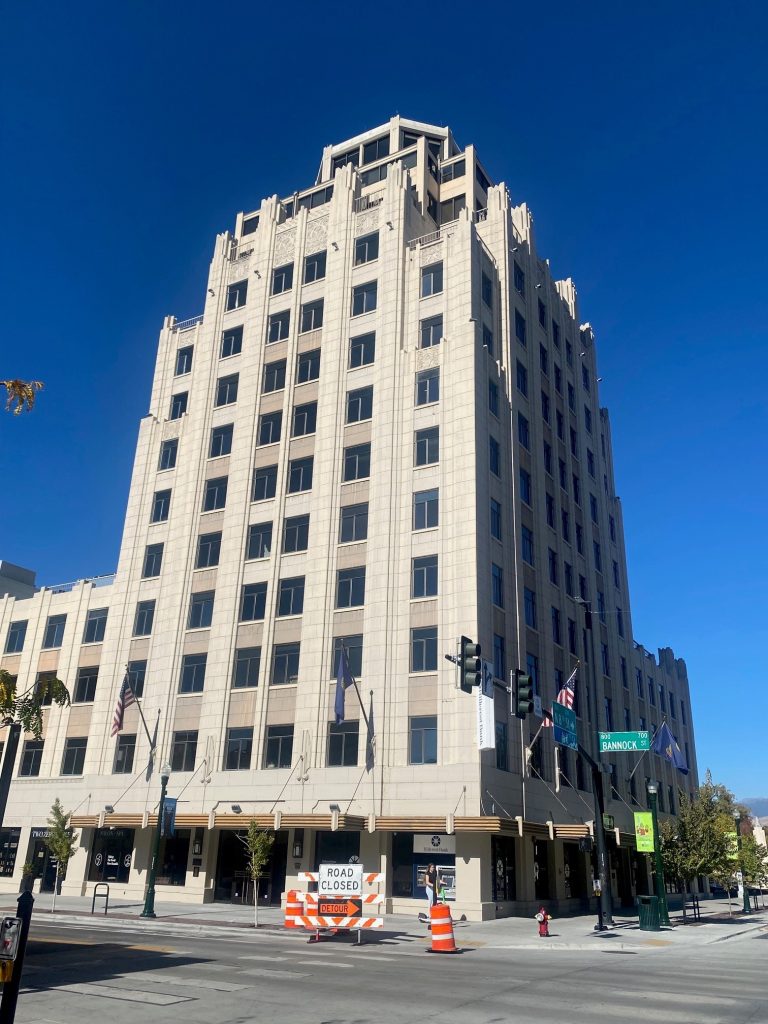
“The lumber is placed upon the lot next to A.H. Crane’s Law Office and a new building is about to be erected. The Building up of our enterprising little town progresses steadily and we hope it will so continue.”[xi]
Two years later the same periodical told its readers:
“James Kent is now comfortably settled in his law office on Sherman Street and ready to receive clients. He has a very neat little place.”[xii]
The Twentieth Century
By the turn of the Century, it was profitable and practical, apparently, for law firms to have more than a single location. The Oakley Herald of September 14, 1905 advertised on its front page that Derbyshire & Dunn have “Offices in Albion and Oakley.”[xiii]
The Idaho State Gazeteer and Business Directory for 1901-1902 reported that the distribution of law offices throughout the state had greatly changes from the former mining era concentration in just a few locations. Forty-eight cities and villages were identified as having lawyers, but the former boom-towns of Idaho City and Silver City each supported just one. By contrast, Boise City had 59 identified, with most being solo practitioners at individual office locations. In the North, Coeur d’Alene had but three offices, but Wallace, twelve lawyers, Moscow, fifteen, and Lewiston a whopping nineteen! In the South, Pocatello listed eight, Idaho Falls seven, Hailey, St. Anthony and Salmon six each and five each were listed in the towns of Caldwell, Weiser, Mt. Home, and Blackfoot.[xiv]
Large, office-block structures, like the Idaho Building at Eighth and Bannock in Boise, would become the much sought after urban office locations of the same era. As a state-of-the-art, six-story, Renaissance Revival-style building built in 1911, it housed, in the most modern-style, the Republication Party Headquarters, the noted architectural firm of Tourtelotte and Hummel, and by 1912, no fewer than 28 lawyers and firms.[xv]
Greeting clients in similar surroundings just down the Street, in the Grunbaum Building, by 1915 then Ex-Governor James H. Hawley was long removed from the tent practice of two decades earlier. The firm name had become “Hawley, Puckett and Hawley.”[xvi]
Boise’s first “skyscraper” was the Hotel Boise, erected in 1930. At eleven floors, with 400 rooms and ten apartments, it operated as a commercial residence until 1976.[xvii] The renovated Hoff Building, with two additional floors added, became an office space structure and law firms immediately became tenants.[xviii] Fifty years later, it still houses both lawyers and lobbyists.
Post-World War II, Idaho began to experience a need for both more lawyers and larger firms. In December of 1956, Governor Robert Smylie presided over the opening of the new 1.6 million dollar six-story, First Security Bank Building at Ninth and Idaho in Downtown Boise.[xix] Among the first tenants therein, by 1964, was the firm of Hawley, Troxell, Ennis and Hawley.[xx]
The sixties and seventies also saw an interest by small and medium sized law firms in two different trends: erecting purpose-built, new construction buildings for self-occupancy, and also in renovating older, well-located residential homes, often with historic and architectural character, for law office use. Examples of both of these types of structures are found throughout the state, often situated very adjacent to the local courthouse. The Derr Law Firm Building exemplifies the purpose-built structures. The former Mike Burkett law building on Thirteenth Street is an example of a cottage-home makeover.
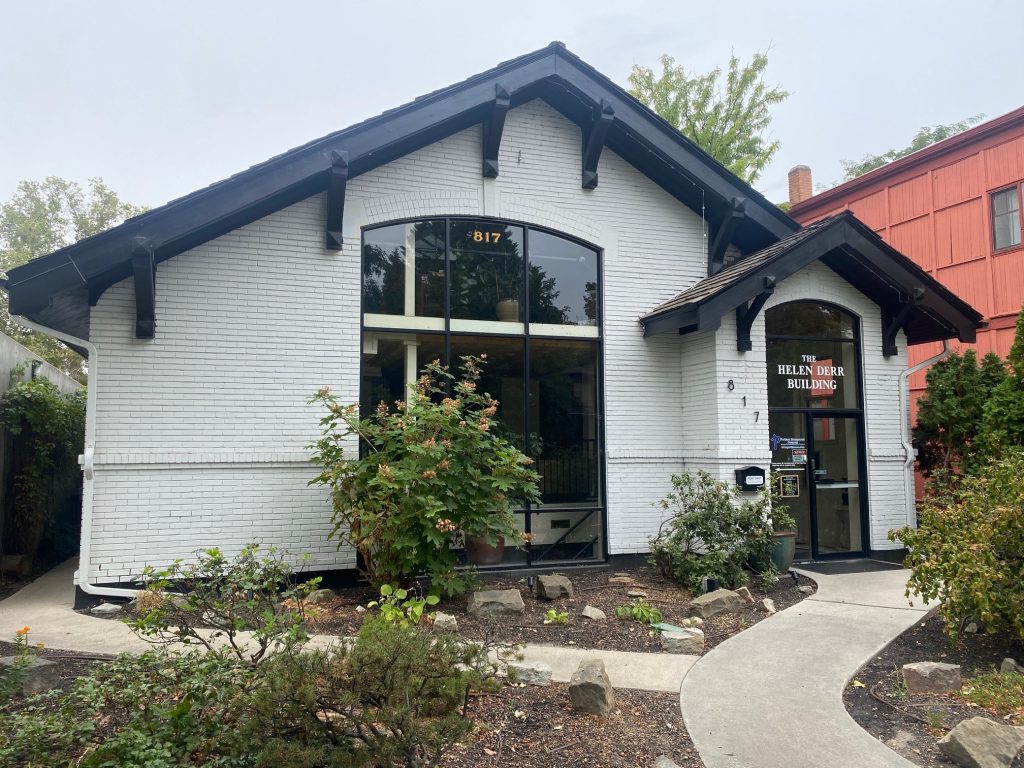
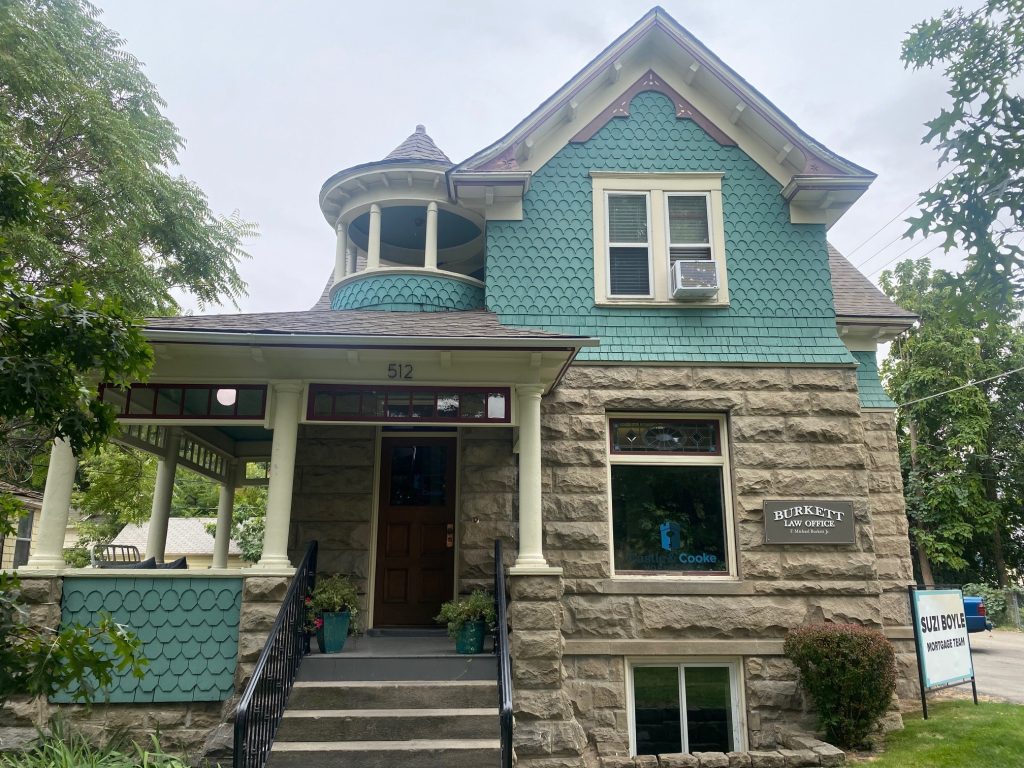
As those smaller firms grew to midsize, in the eighties and nineties, a few even took on the major task of repurposing and occupying historic major structures in their respective communities. Examples of this are the Boise Carnegie Library Building, erected in 1904-1905 and taken over in 1989 by the firm of Clemens, and Cosho, Humphrey,[xxi] and the historic Lewiston Train Depot, which served its original function between its 1909 and 1966, until the last passenger car departed. That station at 1229 Main Street, given new life, is still occupied by the Clark and Feeney law firm today.[xxii]
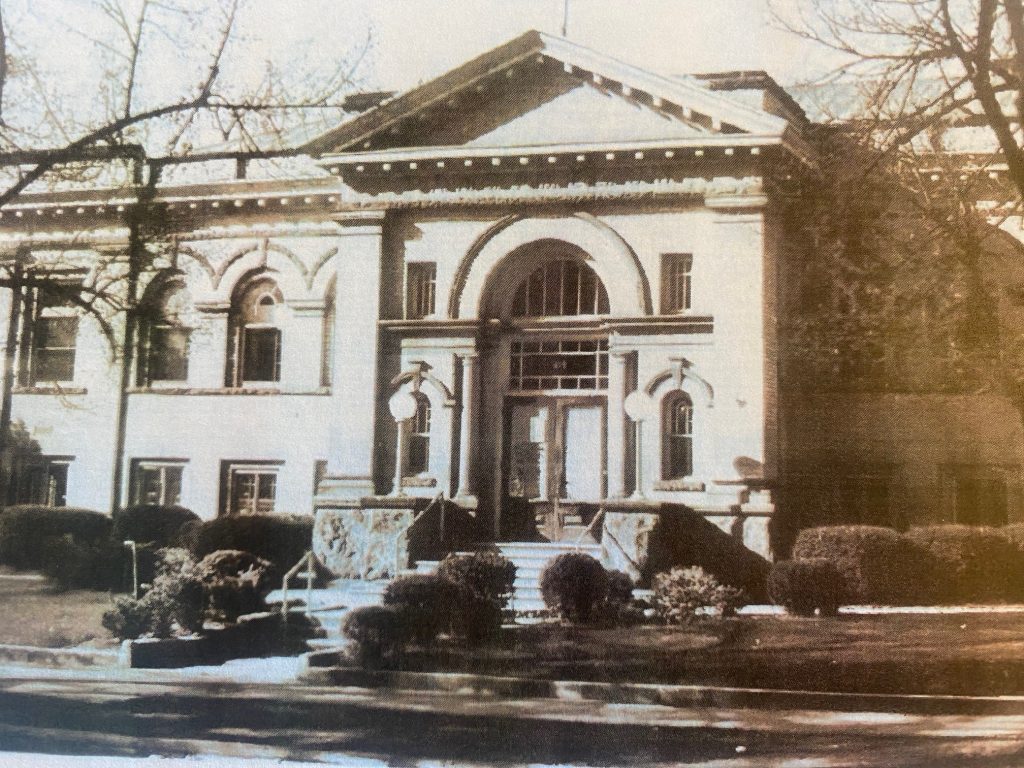
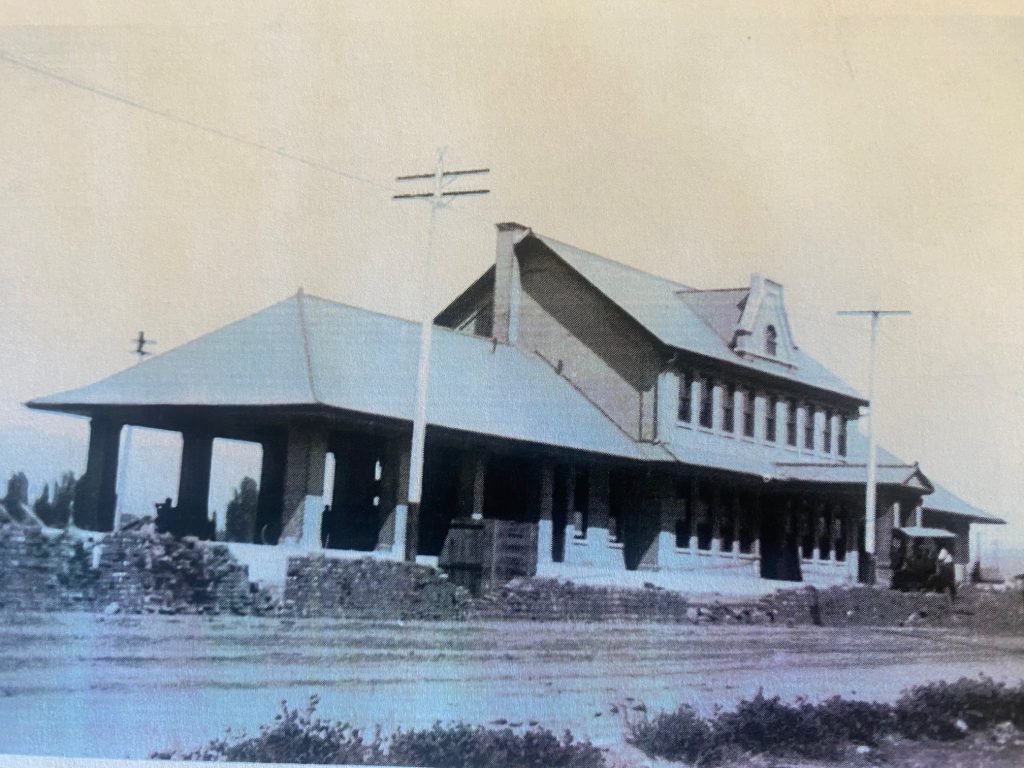
Taller office buildings too, became attractive for housing larger firms, corporate law departments and some government-related legal divisions. For example, Morrison Knutson Construction Company in the 1970s, Boise Cascade Corporation in 1971, and Idaho Power in 1992, built large, vertical corporate buildings with executive suite legal departmental offices.[xxiii] The lawyers were usually located immediately proximate to the quarters of the highest corporate officers.
Private firms, both large and small, began to occupy office towers in Boise as soon as they opened. They remain frequent anchor tenants today. One Capital Center, build in 1975 at fourteen stories tall, the U.S. Bank Plaza in 1978, with nineteen floors, the Key Bank Financial Center at thirteen levels, in 1983, and the Wells Fargo Center of 1988 with eleven floors are examples of that vertical commercial building boom. Collectively, they house approximately twenty law firms today.[xxiv]
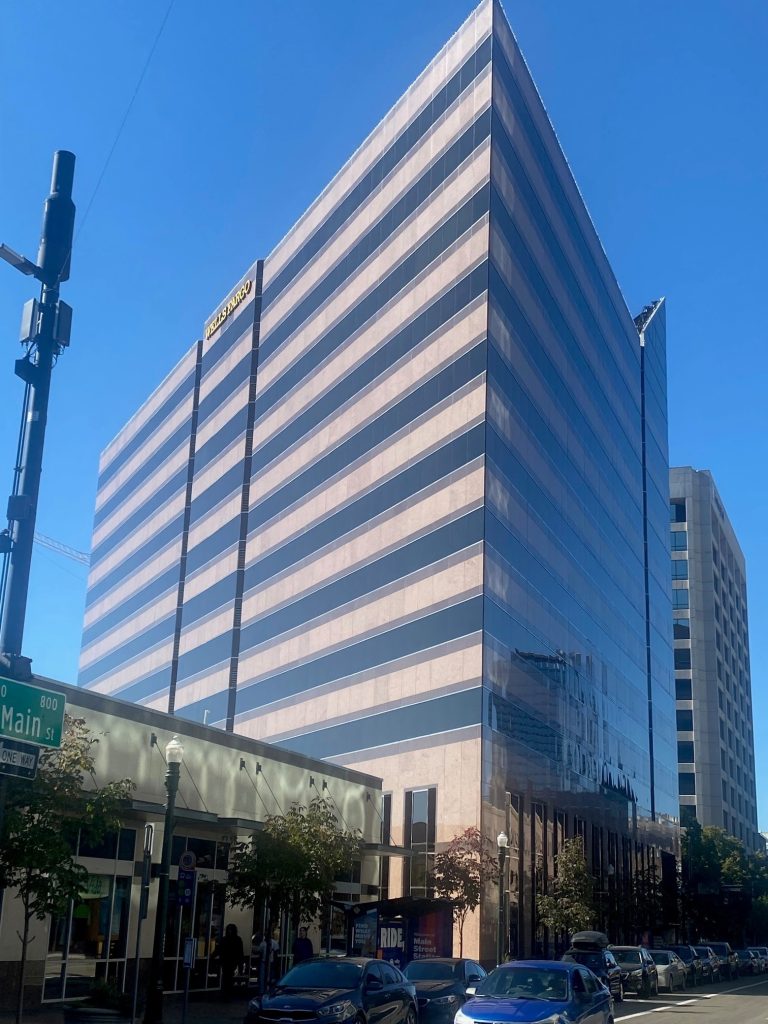
The Twenty First Century
With the new millennium came further urbanization and even more geographic law firm concentration in commercial properties. As more new buildings began to go upward, taking the form of ever-higher towers in Boise, additional law firms began to migrate to these addresses. The Zions Bank – Eighth and Main Building, with eighteen floors, opened in 2013 as Idaho’s tallest building at 232 feet.[xxv] It now houses seven law firms, both large and small. Of particular interest is a fourteenth-floor shared commercial rental space in which twenty varied professionals, three of whom are lawyers, share a conference room and individual offices on a rotating basis. Each also utilizes the address and a single phone answering and reception desk, as needed, as an adjunct to their mostly home-based work process.[xxvi] Two other Boise structures, One Capital Center, and the Banner Bank Building, which debuted in 2007 at 181 feet, also offer similar shared-tenant arrangements.[xxvii] Ironically, completing the trend of “tents to towers,” the Hawley law firm has occupied several suites of the eleven-story Wells Fargo Center.[xxviii]
Since 2008, Coeur d’Alene too has had a multipurpose business and residence tower in the nineteen-story structure at 601 East Front Street. Smith + Malek, with offices both there and on the sixteenth floor of the U.S. Bank Building in Boise, may be Idaho’s first “double-towered” law firm.[xxix]
The Post-COVID Era
The December 2019 onset and subsequent rise, then initial diminution of the COVID pandemic, have had a profound impact on law office operations and locations in Idaho and throughout the United States. Pre-COVID, approximately 5% of small firms and 26% of solo practitioners nationwide made their personal residence their primary law office location, according to the American Bar Association.[xxx]
The law research and data source, Clio’s Legal Trends, reported that by 2020, as COVID struck, an estimated 21% of all lawyers solely utilized a home office location.[xxxi] Apparently post-COVID, this number has only continued to climb, as an ABA survey of nearly 2,000 members done in September of 2022 with nearly two thousand of its members concluded that 30% of lawyers then were practicing from a “kitchen table” home office 100% of the time.[xxxii] However, full-time professional offices at commercial locations have also seen a post-COVID rebound in occupancy and usage. In the Spring of 2022, only 12% of law firms required full time practice at a formal office. By January of 2023, that number had risen to 24% which did not permit any home-based remote work.[xxxiii]
Yet, the kitchen-table trend has also recently become ever more acceptable to law office clients. Clio’s Legal Trends Reports surveyed legal consumers to find the following, ever-increasing percentage of them were becoming more agreeable to work with a lawyer remotely, without a traditional face-to-face conference in a physical office: 2018, 23%; 2019, 32%; 2020, 56%; and by 2021, 79% of law clients were fine with over-the-computer conferences.[xxxiv]
These estimated 2022-2023 national percentages can be projected against the total of 5,521 lawyers currently licensed to practice in Idaho as “best available evidence” to predict our 2024 local office trends.[xxxv] As a best guess, the Gem State may have 1,656 attorneys practicing exclusively from home offices. Likewise, an estimated 1,325 Idaho professionals may practice with large or mid-sized law firms which currently require their full-time attendance at a central commercial location.
Conclusion
Future Idaho law office structures will continue to evolve, as society, communication trends and client preferences change in the coming years. As rural Idaho becomes more populated, the downtown zones of our cities will continue to reflect the towers era. Idaho’s small towns will also likely see stand-alone office practice buildings in increasing numbers, with lawyers occupying both old and new commercial premises and residential conversions. But surely, the increasing commonality of the internet virtual meeting will allow or require ever more impersonal contact between clients and counsel, further diminishing the importance of a bricks and mortar office. This trend will inevitable see even more legal business to be transacted by firms, both large and small, across the home office “kitchen table.” Even Governor Hawley’s circa 1915 oversized oak lawyer’s desk now sits in a home office setting.[xxxvi] Perhaps, one day, even “tents” will come back into style.
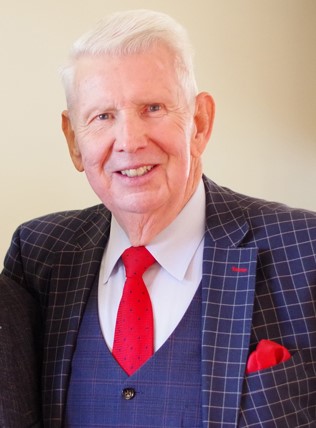
Dave Leroy is a former Ada County Prosecutor, Idaho Attorney General, and Lt. Governor who also served as United States Nuclear Waste Negotiator. With a criminal defense and administrative law practice in Boise, he also finds time to speak and write on history and political topics, travel in search of antiquarian books and frequently appears on national, regional, internet, and local media news shows as a legal commentator. Dave and his wife Nancy donated the 210 original Abraham Lincoln artifacts which comprise the permanent, five room “Lincoln and Idaho” exhibit at the Idaho Archives building, made similar requests to the Nez Perce County Historical Society in Lewiston, and also have historic items on permanent loan inside and outside the Lincoln Auditorium in the Statehouse.
[i] Photograph in the collection of the Idaho State Historical Society, James H. Hawley files.
[ii] Idaho City World (December 26, 1863, page 1).
[iii] Idaho City World (October 13, 1863, page 1).
[iv] Idaho City World (February 26, 1864, page 1).
[v] Idaho Statesman, Boise City (August 4, 1864, page 1).
[vi] Idaho Statesman, Boise City (August 27, 1864, page 1).
[vii] Reports of Cases Argued and Determined in the Supreme Court of Idaho Territory, Volume 1 (1882, pages 1-3).
[viii] En.wikipedia.org/wiki/Richard_Z._Johnson and the website idahoarchitectureproject.org/properties/johnson-law-office.
[ix] “A Sagebrush Lawyer,” John MacFarlane, Pandick Press, Inc., New York (1954) page 20 and “The First 50 Men in Idaho Law,” Debora K. Kristensen, The Advocate (October 2010) page 60.
[x] Reports of Cases Argued and Determined in the Supreme Court of Idaho Territory, Volume 1 (1882, pages 1-3).
[xi] The Coeur d’Alene Press (September 24, 1892, page 1).
[xii] The Coeur d’Alene Press (February 3, 1894, page 3).
[xiii] The Oakley Herald (September 14, 1905, page 1).
[xiv] The Idaho State Gazeteer and Business Directory (1901-1902), pages 444-446.
[xv] R.L. Polk Boise City and Ada County Directory (1912-1913) pages 554-555.
[xvi] R.L. Polk Boise City and Ada County Directory (1915) page 149.
[xvii] En.wikipedia.org/wiki/Hoff_Building.
[xviii] Polks Boise City Directory (1978).
[xix] Hummelarch.com/first-security-bank-downtown-boise.
[xx] Polks Boise City Directory (1964) page 288.
[xxi] 1989 Boise Idaho City Directory, page 152.
[xxii] Historic-structures.com/id/Lewiston/Lewiston-depot and clarkandfeeney.com.
[xxiii] Idahostatesman.com/news/business/article204995744 and nwesi.com/projects/boise-plaza and idahoarchitectureproject.org/Idaho-power-building.
[xxiv] “The 10 Tallest Buildings in Boise” at weknowboise.com/blog and a review of the individual building lobby cards listing tenants.
[xxv] Idahoarchitectureproject.org/properties/banner-bank-building and a review of the lobby cards.
[xxvi] Roy Eiguren, Co-owner and intelligentoffice.com>locations>boise.
[xxvii] The building websites: onecapitalcenter.com and tokcommercial.com/properties?propertyId=banner-bank-building and a review of the lobby cards.
[xxviii] Hawleytroxell.com.
[xxix] Smithmalek.com.
[xxx] American Bar Association, February 5, 2024 at americanbar.org/groups/law-practice/resources.
[xxxi] Clio’s Legal Trends at clio.com/resources/legal-trends/2020.
[xxxii] American Bar Association, October 18, 2023 at fedmanager.com/news/American-bar-association-issues.
[xxxiii] Bloomberg Law Analysis, July 6, 2023 at news.bloomberglaw.com/Bloomberg-law-analysis.
[xxxiv] Clio’s Legal Trends cited in answeringlegal.com/blog/how-viable-is-remote-work.
[xxxv] Number of lawyers according to the Idaho State Bar, Office of Bar Counsel and isb.idaho.gov/licensing-mcle/membership-count-statuses.
[xxxvi] Author’s collection.

